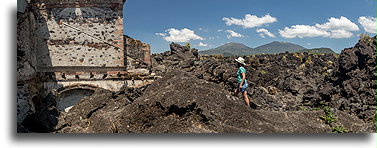Church buried in lava
March 27







During the Parícutin volcano effusive eruption that began in 1943, slow lava flow reached nearby village of Parícutin, destroying it. No one was killed, but the houses could not be rebuilt simply because they were buried under 20 meters/ 65 feet lava layer. Imagine a truck that dumps several loads of concrete directly on your house and backyard. Lava covered everything except the top of the old Franciscan church. Centuries earlier, missionaries had built an impressive sanctuary. The upper part of the San Juan Parangaricutiro church protrudes today above the volcanic deposits.





Walking on lava and staying on the roof level was a unique experience for us. We could touch the intricate decorations high above the entrance. The main altar inside the church escaped the destruction. To this day people come here to pray and bring the offerings. Gifts made to God on the altar include tortillas, sweet bread, oranges, mangos, corn, etc.




After the destruction of Parícutin, new village was built in a distance. Lava rock is the main building material there. Soft rock is especially well suited to for carving the decorations. The volcanic eruption remains deeply in the memory of the local population and it is visible in the local art.


















